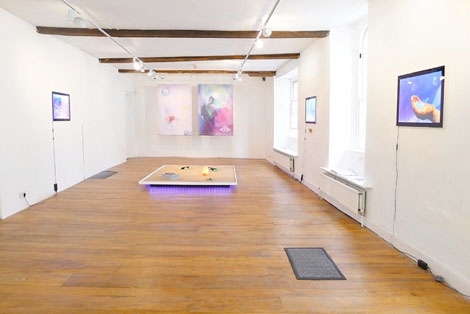Work metadata
- Year Created: 2014
- Submitted to ArtBase: Tuesday Nov 11th, 2014
- Original Url: http://www.tristanstevens.com/fifthwall.html
-
Work Credits:
- tristanstevens, primary creator
Take full advantage of the ArtBase by Becoming a Member
Artist Statement
In the nineteenth century, if an artist painted a Zen garden, and someone seeing the painting asked 'why?", it would probably just have been assumed that the painter thought that the subject would make a good painting, and the onlooker would then simply appreciate the design and the opportunity to look at an interesting subject from a far off land. It would have been an unusual viewer who went on to speculate whether the artist knew anything about Zen and if he or she was in anyway influenced by the philosophy of the East. Even rarer would it have been to ask whether the artist is showing us the garden with approval, or is saying something about their view of life through their painting of it.
With twentieth century and contemporary art, however, such an un-inquisitive attitude would mean the viewer misses a great deal of what the work has to offer, for one can be sure that the artist has chosen the images or the objects that they use with great care and with the intention of speaking directly to the viewer about what matters most to them in their lives, morally, aesthetically, philosophically, politically and spiritually. This is much as it is in the other arts, so that one might read a modern novel, for instance, not only for the experience of the world it depicts but also the philosophy of the author and an understanding of what motivated the writing of the book. In all cases these turn out to be considered reflections on human situations and the experience of life’s pleasures and challenges.
In this frame of mind, reading a novel, one feels that everything is a metaphor. And so it is in the other arts. A Zen garden is already a metaphor in itself, for the rocks and the raked sand are symbols of individual entities in the field of being that the Buddhists intuit is the base of existence. Here in this exhibition it is clear that the Zen garden is a metaphor for something else, for it is set in a room that is decked out like a foyer or reception area to a modern office, and on the holy rocks in the sand rest devices that connect us to the World Wide Web, surely a field of being of another kind, but also one connecting all of us together.
Other metaphors plainly visible here are to do with cleanliness, for there are islands made of soap in the raked garden, and we can be sure that they do not refer entirely to bodily cleanliness. Scent has been used by the church for thousands of years as a symbol or equivalent of spirit and the exhibition includes devices that have been invented to perfume modern working spaces. There are also ‘New Age’ crystals that are said to soak up the negative effects of electronic devices. One need not ask, however, if the artist believes in such things, only if they can be used as an effective metaphor.
Artists are sometimes concerned to use a light touch in this climate of expectation, and Tristan Stevens’ use of the banners and the illuminated signs that give us information in everyday life, rather than the more solemn traditional vehicles of painting and sculpture, perhaps stems from this feeling.
- Christopher Bucklow, 2014





